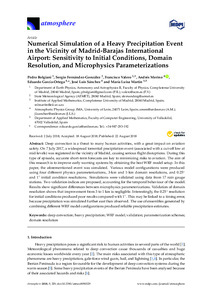Por favor, use este identificador para citar o enlazar este ítem:
http://hdl.handle.net/20.500.11765/10153
Numerical simulation of a heavy precipitation event in the vicinity of Madrid-Barajas international airport: sensitivity to initial conditions, domain resolution, and microphysics parameterizations
| Título : | Numerical simulation of a heavy precipitation event in the vicinity of Madrid-Barajas international airport: sensitivity to initial conditions, domain resolution, and microphysics parameterizations |
| Autor : | Bolgiani, Pedro; Fernández-González, Sergio



|
| Palabras clave : | Deep convection; Heavy precipitation; WRF model; Validation; Parameterization schemes; Domain resolution |
| Fecha de publicación : | 2018 |
| Editor: | Multidisciplinary Digital Publishing Institute |
| Citación : | Atmosphere. 2018, 9(9), 329 |
| Versión del editor: | https://dx.doi.org/10.3390/atmos9090329 |
| Resumen : | Deep convection is a threat to many human activities, with a great impact on aviation safety. On 7 July 2017, a widespread torrential precipitation event (associated with a cut-off low at mid-levels) was registered in the vicinity of Madrid, causing serious flight disruptions. During this type of episode, accurate short-term forecasts are key to minimizing risks to aviation. The aim of this research is to improve early warning systems by obtaining the best WRF model setup. In this paper, the aforementioned event was simulated. Various model configurations were produced using four different physics parameterizations, 3-km and 1-km domain resolutions, and 0.25º and 1º initial condition resolutions. Simulations were validated using data from 17 rain gauge stations. Two validation indices are proposed, accounting for the temporal behaviour of the model. Results show significant differences between microphysics parameterizations. Validation of domain resolution shows that improvement from 3 to 1 km is negligible. Interestingly, the 0.25º resolution for initial conditions produced poor results compared with 1º. This may be linked to a timing error, because precipitation was simulated further east than observed. The use of ensembles generated by combining different WRF model configurations produced reliable precipitation estimates. |
| Patrocinador: | This work was supported by research projects METEORISK (RTC-2014-1872-5), PCIN-2014-013-C07-04, PCIN-2016-080 (UE ERANET Plus NEWA Project), SAFE-FLIGHT (CGL2016-78702-C2-1-R and CGL2016-78702-C2-2-R), ESP2013-47816-C4-4-P, CGL2010-15930, CGL2016-81828-REDT, FEI-EU-17-16, and the Instituto de Matemática Interdisciplinar (IMI) of the Universidad Complutense. |
| URI : | http://hdl.handle.net/20.500.11765/10153 |
| ISSN : | 2073-4433 |
| Colecciones: | Artículos científicos 2015-2018 |
Ficheros en este ítem:
| Fichero | Descripción | Tamaño | Formato | ||
|---|---|---|---|---|---|
| Numerical_Simulation_... | 4,05 MB | Adobe PDF |  Visualizar/Abrir |
Los ítems de Arcimis están protegidos por una Licencia Creative Commons, salvo que se indique lo contrario.





